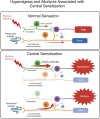Pain pathophysiology and pharmacology of cattle: how improved understanding can enhance pain prevention, mitigation, and welfare
- PMID: 39258013
- PMCID: PMC11385012
- DOI: 10.3389/fpain.2024.1396992
Pain pathophysiology and pharmacology of cattle: how improved understanding can enhance pain prevention, mitigation, and welfare
Abstract
Globally, humans rely on cattle for food production; however, there is rising societal concern surrounding the welfare of farm animals. From a young age, cattle raised for dairy and beef production experience pain caused by routine management procedures and common disease conditions. The fundamental mechanisms, nociceptive pathways, and central nervous system structures required for pain perception are highly conserved among mammalian species. However, there are limitations to a comparative approach to pain assessment due to interspecies differences in the expression of pain. The stoicism of prey species may impede pain identification and lead to the assumption that cattle lack pain sensitivity. This highlights the importance of establishing validated bovine-specific indicators of pain-a prerequisite for evidence-based pain assessment and mitigation. Our first objective is to provide an overview of pain pathophysiology to illustrate the importance of targeted analgesia in livestock medicine and the negative welfare outcomes associated with unmitigated pain. This is followed by a review of available analgesics, the regulations governing their use, and barriers to implementation of on-farm pain management. We then investigate the current research undertaken to evaluate the pain response in cattle-a critical aspect of the drug approval process. With an emphasis on emerging research in animal cognition and pain pathology, we conclude by discussing the significant influence that pain has on cattle welfare and areas where further research and modified practices are indicated.
Keywords: analgesia; animal welfare; cattle; cow; pain; pain management.
© 2024 Zoltick, Mann and Coetzee.
Conflict of interest statement
The authors declare that the research was conducted in the absence of any commercial or financial relationships that could be construed as a potential conflict of interest.
Figures



Similar articles
-
Pain Management in Farm Animals: Focus on Cattle, Sheep and Pigs.Animals (Basel). 2021 May 21;11(6):1483. doi: 10.3390/ani11061483. Animals (Basel). 2021. PMID: 34063847 Free PMC article. Review.
-
A nationwide survey on producer and veterinarian perceptions of the painfulness of procedures and disease states in dairy and beef cattle.Front Pain Res (Lausanne). 2023 Feb 1;4:1059224. doi: 10.3389/fpain.2023.1059224. eCollection 2023. Front Pain Res (Lausanne). 2023. PMID: 36817621 Free PMC article.
-
Harnessing the value of reproductive hormones in cattle production with considerations to animal welfare and human health.J Anim Sci. 2022 Jul 1;100(7):skac177. doi: 10.1093/jas/skac177. J Anim Sci. 2022. PMID: 35772763 Free PMC article. Review.
-
Pain in Dairy Cattle: A Narrative Review of the Need for Pain Control, Industry Practices and Stakeholder Expectations, and Opportunities.Animals (Basel). 2025 Mar 19;15(6):877. doi: 10.3390/ani15060877. Animals (Basel). 2025. PMID: 40150408 Free PMC article. Review.
-
Graduate Student Literature Review: Role of pain mitigation on the welfare of dairy calves undergoing disbudding.J Dairy Sci. 2022 Aug;105(8):6809-6819. doi: 10.3168/jds.2021-21349. Epub 2022 Jun 7. J Dairy Sci. 2022. PMID: 35688730 Review.
Cited by
-
Medicated Meloxicam Pellets Reduce Some Indicators of Pain in Disbudded Dairy Calves.Animals (Basel). 2025 Jun 3;15(11):1641. doi: 10.3390/ani15111641. Animals (Basel). 2025. PMID: 40509112 Free PMC article.
References
-
- de Lahunta A, Glass E, Kent M. General sensory systems: general proprioception and general somatic afferent. In: de Lahunta A, Glass E, Kent M, editors. Veterinary Neuroanatomy and Clinical Neurology. 4th ed. St. Louis. MO: Saunders Elsevier; (2015). p. 237–56.
-
- Purves D, Augustine GJ, Fitzpatrick CE, Katz LC, LaMantia AS, McNamara JO, et al. Nociceptors. In: Purves D, Augustine GJ, Fitzpatrick CE, Katz LC, LaMantia A-S JOM, editors. Neuroscience. Sunderland, MA: Sinauer Associates, Inc. (2001). p. 209–22.
-
- Weary DM, Niel L, Flower FC, Fraser D. Identifying and preventing pain in animals. Appl Anim Behav Sci. (2006) 100(1–2):64–76. 10.1016/j.applanim.2006.04.013 - DOI
-
- Marquette GA, Ronan S, Earley B. Calf disbudding—animal welfare considerations. J Appl Anim Res. (2023) 51(1):616–23. 10.1080/09712119.2023.2264912 - DOI
Publication types
LinkOut - more resources
Full Text Sources

